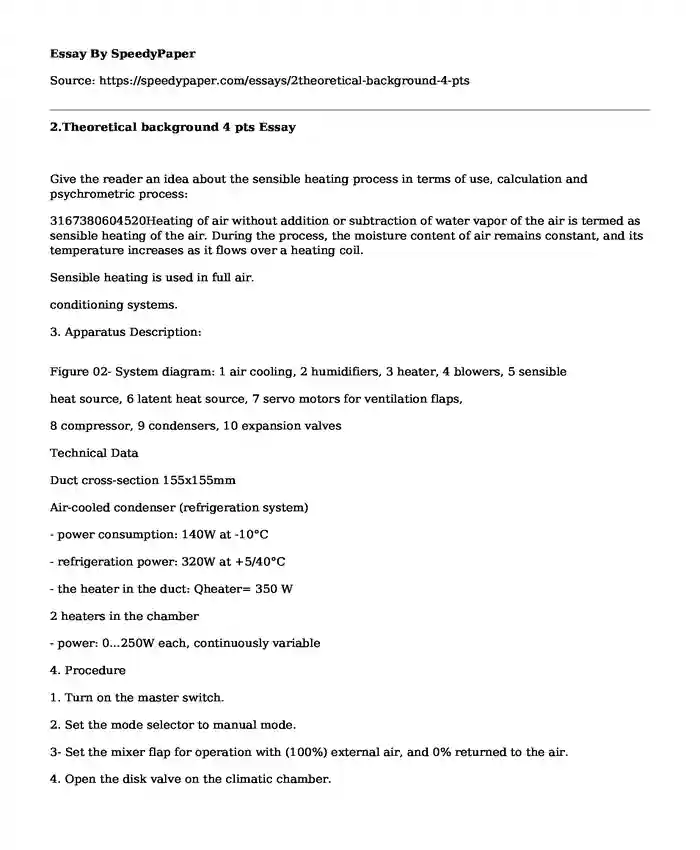
| Type of paper: | Report |
| Categories: | Psychology Marketing Business Literature Human |
| Pages: | 3 |
| Wordcount: | 572 words |
Give the reader an idea about the sensible heating process in terms of use, calculation and psychrometric process:
3167380604520Heating of air without addition or subtraction of water vapor of the air is termed as sensible heating of the air. During the process, the moisture content of air remains constant, and its temperature increases as it flows over a heating coil.
Sensible heating is used in full air.
conditioning systems.
3. Apparatus Description:
Figure 02- System diagram: 1 air cooling, 2 humidifiers, 3 heater, 4 blowers, 5 sensible
heat source, 6 latent heat source, 7 servo motors for ventilation flaps,
8 compressor, 9 condensers, 10 expansion valves
Technical Data
Duct cross-section 155x155mm
Air-cooled condenser (refrigeration system)
- power consumption: 140W at -10C
- refrigeration power: 320W at +5/40C
- the heater in the duct: Qheater= 350 W
2 heaters in the chamber
- power: 0...250W each, continuously variable
4. Procedure
1. Turn on the master switch.
2. Set the mode selector to manual mode.
3- Set the mixer flap for operation with (100%) external air, and 0% returned to the air.
4. Open the disk valve on the climatic chamber.
5- Turn on the fan.
6- Turn on the heater element ON
7- Operate the RACT for approx. 10-15 minutes until steady state.
10- Read the DBTs and RHs of air at locations 4,5
11- Fill table.1 with the recorded data obtained during the experiment
Dry Bulb Temp before the heating coil DBT4 [ oC] 26.5
Relative Humidity after the heating coil RH4 [%] 63.3
Dry Bulb Temp after the Heater DBT4 [ oC] 34.3
Relative Humidity after the Heater RH 5 [%] 38.3
The air velocity in the duct system V [m/s] 0.54
Table. 1 Experimental result
5- Questions:
1- Represent the process on the psychrometric chart. 2 pts
2. Fill table.2 using the data recorded and the psychrometric chart, 2 pts
3. Calculate the mass flow rate of air ma 2 pts
4- Calculate the following
a- the heating rate Q4-5 in kW. 2 pts
b- Compare Q4-5 with Q heater 2 pts
5- Discuss your results in terms of the difference between Q4-5 and Q heater and the process shown on the psychrometric chart 4 pts
6- conclusion 1 pt
Total ....../15
00
Enthalpy before the heating coil h4 [kJ/kg] 62
Enthalpy after the heating coil h5 [kJ/kg] 69
Specific volume v4 [m3/kg] 0.868
Calculations
3) ma= (Area x Velocity)/ Specific volume
= (0.155 x 0.155 x 0.54)/ 0.868
= 0.0149 Kg/s
4) Q(4-5)= ma (H5-H4)
= 0.0149(69-62)x 1000
= 104.3 W
b) The Q heater turned out to bed greater than Q (4-5) by more than 3 times
Discussion
From the experiment, it can be observed that the heat of the heater is higher than the heating rate registered when the air was being sensibly heated. The heater was three times hooter compared to the heating rate in which the heat was being discharged to the environment. It is primarily because the coil that is used to heat the air sensibly is first heated using the power from the source, which is of more considerable energy, as diffusion of heat operates from the coil as the air is passed over it during the process of sensible heating of the air.
On the other hand, sensible heating can be seen to be represented by a horizontal line on the psychrometric chart. It starts from the original dew point temperature of the air while ending at the final temperature which extends to the right.
Conclusion
In conclusion, it can be established the heater temperature is much higher than the heating rate of the air during the sensible heating process. Also, the sensible heating is represented by a horizontal line beginning from the dew point to the right direction in the psychrometric chart.
Cite this page
2.Theoretical background 4 pts. (2023, Jan 10). Retrieved from https://speedypaper.com/essays/2theoretical-background-4-pts
Request Removal
If you are the original author of this essay and no longer wish to have it published on the SpeedyPaper website, please click below to request its removal:
- Free Essay on Modern Technology Used in Agriculture
- The Challenge of Crime in a Free Society
- Teaching Essay Sample: Reading Mini-Lessons
- Essay Sample: Violent Video Games and Aggression in Children
- Movie Review Essay Sample: The Apology (2016) Critical Analysis
- Paper Example on English Colonization and the American Revolution
- American Auto Suppliers' Expansion to Japan: A Cultural Case Study
Popular categories




